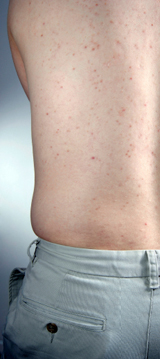
Truncal acne describes acne outbreaks on the back, neck, chest, and arms. It is acne on the body.
Although truncal acne my be concealed by clothing, it can cause emotional distress and lead to persistent acne scars if left untreated.
What causes truncal acne?
Truncal acne is caused by the same chain of events that leads to acne on the face.
An overgrowth of sebum in a clogged hair follicle causes inflammation. This results in bumps called comedones (whiteheads and blackheads).
When the clogged pores become infected with a bacteria called P. acnes, the comedones become inflamed, red, and painful. This leads to the nodules and cysts of inflammatory acne. More commonly, these acne lesions are called zits and pimples.
Because the back, chest, arms, and buttocks are covered with sebaceous glands (which secrete sebum to protect and moisturize the skin), these areas are as susceptible to acne as the face is. This is especially true during puberty, when sebaceous glands produce more sebum due to the hormonal changes of adolescence.
How is truncal acne different than facial acne?
Although the causes of truncal and facial acne are similar, the triggers may be different. For example, clothing that covers the body is more likely to trap sweat, oils, and other substances that can clog pores, creating an ideal condition for breakouts, especially after exercise or working in a warm environment, such as a kitchen.
The treatment of truncal acne is also different from facial acne. The thicker skin of the body can withstand acne medications that might be irritating to facial skin. The thicker skin also makes truncal acne slower to respond to treatment.
This makes it important to remain on therapy as recommend by your physician.
Reluctance to talk about truncal acne
Over 1/2 of patients visiting their dermatologist for facial acne also had acne elsewhere on their body that they did not report to their physician. Not talking about body acne makes likely that it is not sufficiently treated.
How is truncal acne treated?
Acne treatment for the body uses the same methods as those for acne on the face, including:
- Over-the-counter medications applied on the skin, such as benzoyl peroxide.
- Prescription acne medications applied on the skin, such as topical retinoids and antibiotics.
- Oral prescription medications, such as oral antibiotics, isotretinoin, and oral contraceptives.
Challenges that are unique to truncal acne:
- Acne on large areas of the body or hard-to-reach spots, such as the back, may make it difficult to apply topical acne medications.
- Some topical acne treatments may discolor or bleach clothing.
- Left untreated, truncal acne may lead to a type of scarring called follicular macular atrophy.
In choosing a treatment for truncal acne, dermatologists will take into account several factors:
- Severity—Mild acne or moderate acne may respond to topical medications alone, while more severe acne may require oral medications.
- Results of previous acne treatments
- Gender. Some treatments are only available for females, such as birth control pills.
- Location. In a hard-to-reach area, a topical foam (such as clindamycin) may be easier to apply than a thick ointment or gel.
- Clothing. Some patients with truncal acne may have to try different topical acne treatments to find one that won’t stain clothing.
In some cases, dermatologists will combine topical and oral acne medications.
How can I prevent future outbreaks of truncal acne?
To minimize truncal acne, follow these guidelines:
- Clean skin gently twice a day with mild soap and pat dry.
- Do not pick at acne lesions, as this can cause scarring and other skin damage.
- Give your acne treatment time to work—your skin may look worse before it starts to improve, and stopping early can prevent you from seeing good results.
- Wear loose-fitting breathable fabrics (such as cotton or linen) to keep skin well ventilated and prevent clogged pores.
- After exercising, remove snug-fitting clothing that may trap sweat or dirt.
- Shower and gently clean your skin after exercising or any activity that makes you perspire.
Source: Vivacare
Last updated : 2/5/2021